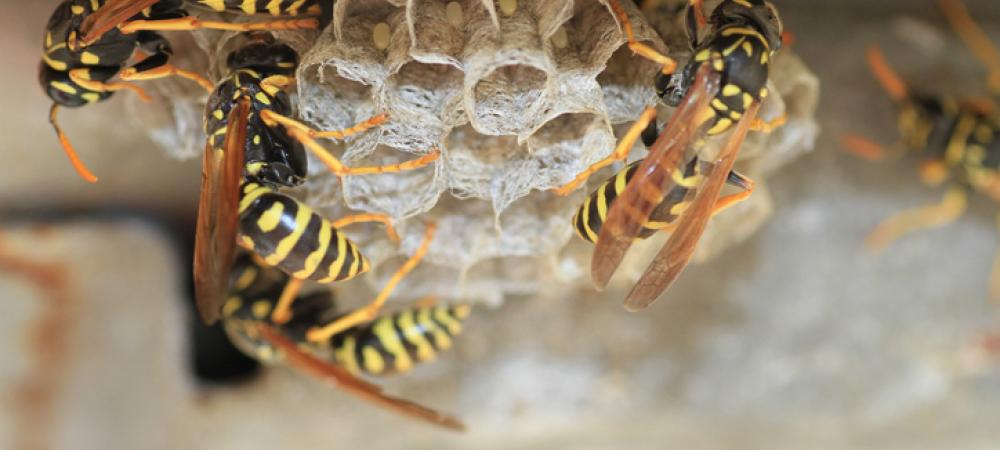What Attracts Stinging Insects and How to Keep Them Out in Oregon

Table of Contents
- What Attracts Stinging Insects in Oregon?
- How to Keep Stinging Insects Out
- Stinging Insect Season in Oregon
- When to Call a Professional
Stinging insects are a common seasonal problem in Oregon, especially during the warmer months. Wasps, hornets, yellowjackets, and carpenter bees often show up uninvited—and bring the risk of painful stings, aggressive behavior, and hidden nests around your property.
Whether you're hosting an outdoor BBQ or just trying to enjoy your backyard, these pests can quickly turn a relaxing day into a stressful one. Understanding what draws them in and how to keep them out is the first step in preventing problems before they start.
What Attracts Stinging Insects in Oregon?
If you’re dealing with stinging insects around your property, it’s likely something nearby is attracting them. These pests are highly motivated by food, water, and places to build their nests—and Oregon’s environment provides plenty of opportunities. Here’s what commonly draws them in:
Sugary Foods & Sweet Scents
- Overripe fruit left on trees or the ground
- Open soda cans or juice containers
- Compost bins with fruit peels or sugary scraps
- Hummingbird feeders that leak or spill
Protein Sources
- Leftovers from outdoor grilling
- Pet food bowls left outside
- Open garbage cans or bags
Standing Water
- Bird baths and fountains
- Clogged gutters or downspouts
- Puddles in lawn furniture or equipment
Shelter & Nesting Sites
- Roof eaves and attic spaces
- Wall voids, sheds, and garages
- Dense trees, bushes, or brush piles
Flowering Plants
- Native Oregon plants that attract pollinators
- Overgrown flower beds and blooming shrubs
Rotting Wood
- A favorite for carpenter bees
- Also attractive to hornets looking for nesting materials
These elements are all part of a natural outdoor environment—but minimizing their accessibility is key to preventing stinging insect activity.
How to Keep Stinging Insects Out
Once you know what attracts them, the next step is making your property less appealing. Prevention is the most effective way to reduce your chances of dealing with nests or aggressive swarms.
Seal Entry Points
- Use caulk around windows and doors
- Repair or replace damaged screens
- Close attic vents and gaps in soffits or fascia
Eliminate Attractants
- Clean up food and drink immediately after outdoor meals
- Keep trash bins tightly sealed
- Pick up fallen fruit regularly
Remove Standing Water
- Refresh bird baths and fountains often
- Empty buckets, flower pots, or toys that collect rain
- Maintain your gutters and downspouts
Use Repellent Plants
- Mint, eucalyptus, and citronella are all natural deterrents
- These plants are safe and thrive in Oregon gardens
Install Decoy Nests
- Wasps are territorial and avoid areas with existing colonies
- Hanging decoys can discourage new nest-building
Do Regular Inspections
- Walk your property in early spring to spot new nest activity
- Check eaves, attic spaces, sheds, and dense shrubbery
Consider Preventive Pest Control
- If you’ve had issues in the past, proactive treatments can help
- Regular service can prevent nests from becoming established
Combining these strategies will help keep your space safer and more comfortable during the height of stinging insect season.
Stinging Insect Season in Oregon
Knowing when to expect activity can help you plan and protect your home more effectively.
Spring
- Queens emerge from overwintering and begin building nests
- Early prevention efforts are most effective in this stage
Summer
- Peak colony activity: worker numbers increase, food needs grow
- This is the most common time for stings and sightings
Late Summer/Fall
- Food sources dwindle, making insects more aggressive
- More likely to invade outdoor events or enter homes
Winter
- Most nests die off, but queens seek shelter to overwinter
- Attics, sheds, and wall voids are common hideouts
By understanding their seasonal patterns, you can stay ahead of infestations and reduce the risk of encountering aggressive behavior.
When to Call a Professional
Some stinging insect situations are too risky or difficult to handle on your own. If any of the following applies, it’s time to bring in a licensed pest control expert:
- The nest is hidden, hard to reach, or located inside your walls
- Insects are swarming, flying aggressively, or stinging frequently
- You’ve tried to handle the issue but it keeps coming back
- You’re allergic or unsure of the species and don’t want to take a chance
Professional stinging insect exterminators in Oregon have the tools and experience to safely remove nests and treat the area to help prevent future problems. Regular inspections and early action can make a big difference too. Don’t wait until a small issue becomes a big one—stay aware, stay safe, and keep your outdoor spaces sting-free all season long.
